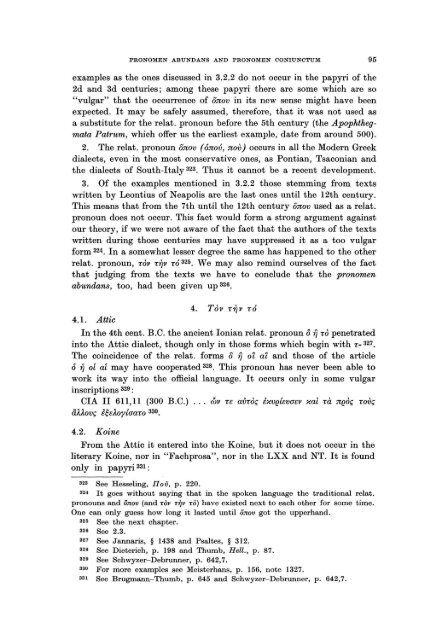Pronomen Abundans and Pronomen Coniunctum. A ... - DWC
Pronomen Abundans and Pronomen Coniunctum. A ... - DWC
Pronomen Abundans and Pronomen Coniunctum. A ... - DWC
You also want an ePaper? Increase the reach of your titles
YUMPU automatically turns print PDFs into web optimized ePapers that Google loves.
PRONOMEN ABUNDANS AND PRONOMEN CONIUNCTUM 95<br />
examples as the ones discussed in 3.2.2 do not occur in the papyri of the<br />
2d <strong>and</strong> 3d centuries; among these papyri there are some which are so<br />
"vulgar" that the occurrence of önov in its new sense might have been<br />
expected. It may be safely assumed, therefore, that it was not used as<br />
a substitute for the relat. pronoun before the 5th century (the Apophthegmata<br />
Patrum, which offer us the earliest example, date from around 500).<br />
2. The relat. pronoun önov (ónov, nov) occurs in all the Modern Greek<br />
dialects, even in the most conservative ones, as Pontian, Tsaconian <strong>and</strong><br />
the dialects of South-Italy 323. Thus it cannot be a recent development.<br />
3. Of the examples mentioned in 3.2.2 those stemming from texts<br />
written by Leontius of Neapolis are the last ones until the 12th century.<br />
This means that from the 7th until the 12th century önov used as arelat.<br />
pronoun does not occur. This fa ct would form a strong argument against<br />
our theory, if we were not aware of the fact that the authors of the texts<br />
written during those centuries may have suppressed it as a too vulgar<br />
form 324. In a somewhat lesser degree the same has happened to the ot her<br />
relat. pronoun, TOY T~Y TÓ 325. We mayalso remind ourselves of the fact<br />
that judging from the texts we have to conclude that the pronomen<br />
abundans, too, had been given up 326.<br />
4. Toy T~Y TÓ<br />
4.1. Attic<br />
In the 4th cent. B.C. the ancient Ionian relat. pronoun (} 1] TO penetrated<br />
into the Attic dialect, though only in those forms which begin with T- 327.<br />
The coincidence of the relat. forms (} 1] oï aï <strong>and</strong> those of the article<br />
ó ~ Ol al may have cooperated 328 . This pionoun has never been able to<br />
work its way into the official language. It occurs only in some vulgar<br />
inscriptions 329 :<br />
CIA II 611,11 (300 B.C.) ... J)'JI Te aVToç f:x,v(!{evaey "al Tà n(!oç rovç<br />
aÀ.A.ovç è~eAoy{aaTo 330.<br />
4.2. Koine<br />
From the Attic it entered into the Koine, but it does not occur in the<br />
literary Koine, nor in "Fachprosa", nor in the LXX <strong>and</strong> NT. It is found<br />
only in papyri 331 :<br />
323 See Hesseling, II OV, p. 220.<br />
324 It goes without saying that in the spoken language the traditional relat.<br />
pronouns <strong>and</strong> 8nov (<strong>and</strong> TOV rYlv TO) have existed next to each other for some time.<br />
One can only guess how long it lasted until 8nov got the upperh<strong>and</strong>.<br />
325 See the next chapter.<br />
326 See 2.3.<br />
327 See Jannaris, § 1438 <strong>and</strong> Psaltes, § 312.<br />
328 See Dieterich, p . 198 <strong>and</strong> Thumb, Hell., p. 87.<br />
329 See Schwyzer-Debrunner, p. 642,7.<br />
330 For more examples see Meisterhans, p . 156, note 1327.<br />
331 See Brugmann- Thumb, p. 645 <strong>and</strong> Schwyzer-Debrunner, p. 642,7.
















